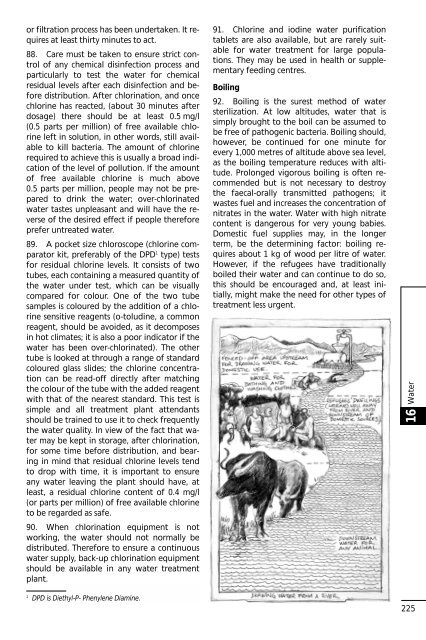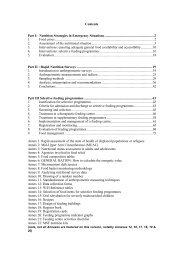UNHCR Handbook for Emergencies - UNHCR eCentre
UNHCR Handbook for Emergencies - UNHCR eCentre
UNHCR Handbook for Emergencies - UNHCR eCentre
You also want an ePaper? Increase the reach of your titles
YUMPU automatically turns print PDFs into web optimized ePapers that Google loves.
or filtration process has been undertaken. It requires<br />
at least thirty minutes to act.<br />
88. Care must be taken to ensure strict control<br />
of any chemical disinfection process and<br />
particularly to test the water <strong>for</strong> chemical<br />
residual levels after each disinfection and be<strong>for</strong>e<br />
distribution. After chlorination, and once<br />
chlorine has reacted, (about 30 minutes after<br />
dosage) there should be at least 0.5 mg/l<br />
(0.5 parts per million) of free available chlorine<br />
left in solution, in other words, still available<br />
to kill bacteria. The amount of chlorine<br />
required to achieve this is usually a broad indication<br />
of the level of pollution. If the amount<br />
of free available chlorine is much above<br />
0.5 parts per million, people may not be prepared<br />
to drink the water; over-chlorinated<br />
water tastes unpleasant and will have the reverse<br />
of the desired effect if people there<strong>for</strong>e<br />
prefer untreated water.<br />
89. A pocket size chloroscope (chlorine comparator<br />
kit, preferably of the DPD1 type) tests<br />
<strong>for</strong> residual chlorine levels. It consists of two<br />
tubes, each containing a measured quantity of<br />
the water under test, which can be visually<br />
compared <strong>for</strong> colour. One of the two tube<br />
samples is coloured by the addition of a chlorine<br />
sensitive reagents (o-toludine, a common<br />
reagent, should be avoided, as it decomposes<br />
in hot climates; it is also a poor indicator if the<br />
water has been over-chlorinated). The other<br />
tube is looked at through a range of standard<br />
coloured glass slides; the chlorine concentration<br />
can be read-off directly after matching<br />
the colour of the tube with the added reagent<br />
with that of the nearest standard. This test is<br />
simple and all treatment plant attendants<br />
should be trained to use it to check frequently<br />
the water quality. In view of the fact that water<br />
may be kept in storage, after chlorination,<br />
<strong>for</strong> some time be<strong>for</strong>e distribution, and bearing<br />
in mind that residual chlorine levels tend<br />
to drop with time, it is important to ensure<br />
any water leaving the plant should have, at<br />
least, a residual chlorine content of 0.4 mg/l<br />
(or parts per million) of free available chlorine<br />
to be regarded as safe.<br />
90. When chlorination equipment is not<br />
working, the water should not normally be<br />
distributed. There<strong>for</strong>e to ensure a continuous<br />
water supply, back-up chlorination equipment<br />
should be available in any water treatment<br />
plant.<br />
1 DPD is Diethyl-P- Phenylene Diamine.<br />
91. Chlorine and iodine water purification<br />
tablets are also available, but are rarely suitable<br />
<strong>for</strong> water treatment <strong>for</strong> large populations.<br />
They may be used in health or supplementary<br />
feeding centres.<br />
Boiling<br />
92. Boiling is the surest method of water<br />
sterilization. At low altitudes, water that is<br />
simply brought to the boil can be assumed to<br />
be free of pathogenic bacteria. Boiling should,<br />
however, be continued <strong>for</strong> one minute <strong>for</strong><br />
every 1,000 metres of altitude above sea level,<br />
as the boiling temperature reduces with altitude.<br />
Prolonged vigorous boiling is often recommended<br />
but is not necessary to destroy<br />
the faecal-orally transmitted pathogens; it<br />
wastes fuel and increases the concentration of<br />
nitrates in the water. Water with high nitrate<br />
content is dangerous <strong>for</strong> very young babies.<br />
Domestic fuel supplies may, in the longer<br />
term, be the determining factor: boiling requires<br />
about 1 kg of wood per litre of water.<br />
However, if the refugees have traditionally<br />
boiled their water and can continue to do so,<br />
this should be encouraged and, at least initially,<br />
might make the need <strong>for</strong> other types of<br />
treatment less urgent.<br />
Water<br />
16<br />
225



